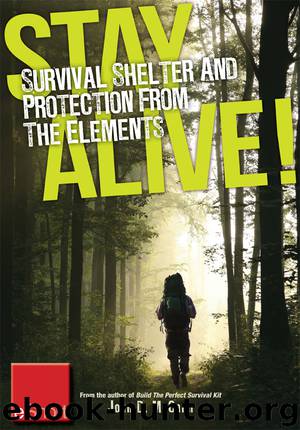Stay Alive -- Survival Shelter and Protection from the Elements eShort by John McCann

Author:John McCann [McCann, John D.]
Language: eng
Format: epub
ISBN: 978-1-4402-3536-8
Publisher: F+W Media
Published: 2011-04-04T04:00:00+00:00
Choosing a location for your shelter
Okay, you are in a survival situation and need shelter. Before initiating construction, several factors must be considered. First, think ahead. It is much easier to build a shelter in the light than in the dark. Don’t wait too late in the day to get started. If you know you’ll be spending the night out there, start early, get your shelter built and get comfortable.
The weather is another factor. What do you have to protect yourself from? In the summer, it might be rain, wind or a drop in temperature. In winter, you have more to consider. Temperatures will be much lower and insulation will be more important.
As with real estate, think location, location, location! Try to locate your shelter near sufficient shelter-building materials if you need them. Try to be near water (but not too close), fuel for fire, a signal/recovery area and food, if available. Is the location safe for a fire?
When possible, choose a location that is dry and well drained. Don’t set up your shelter in a water run-off area, as you might get swept away in a downpour. Avoid animal trails, since you wouldn’t want a large animal trampling you at night as they travel down their trail.
Try to have an open southern exposure, with the entryway facing east or southeast. You want the wind to the back or side of the shelter, depending on the type of shelter. What you don’t want is the wind blowing directly into your shelter.
You need a location that is large enough for you to comfortably lie down but small enough to conserve heat. Look for natural barriers that could help to block wind or reflect heat from a fire.
Avoid areas that could pose a threat from flooding, avalanches, mud slides, rock slides and falling trees. I always tell students, “look up.” Nothing will ruin your sleep like a dead tree or limb falling on your shelter in the night. Large dead limbs are called “widow makers” for a reason.
Download
This site does not store any files on its server. We only index and link to content provided by other sites. Please contact the content providers to delete copyright contents if any and email us, we'll remove relevant links or contents immediately.
Periodization Training for Sports by Tudor Bompa(7937)
Bodyweight Strength Training by Jay Cardiello(7683)
Therapeutic Modalities for Musculoskeletal Injuries, 4E by Craig R. Denegar & Ethan Saliba & Susan Saliba(7602)
Born to Run: by Christopher McDougall(6906)
Imperfect by Sanjay Manjrekar(5687)
Wiseguy by Nicholas Pileggi(5336)
Shoe Dog by Phil Knight(4908)
Paper Towns by Green John(4815)
The Body: A Guide for Occupants by Bill Bryson(4603)
The Rules Do Not Apply by Ariel Levy(4540)
Endurance: Shackleton's Incredible Voyage by Alfred Lansing(4520)
Bodyweight Strength Training Anatomy by Bret Contreras(4486)
Tuesdays with Morrie by Mitch Albom(4414)
Yoga Anatomy by Kaminoff Leslie(4112)
The Sports Rules Book by Human Kinetics(4087)
Science and Development of Muscle Hypertrophy by Brad Schoenfeld(3974)
Dynamic Alignment Through Imagery by Eric Franklin(3931)
Exercise Technique Manual for Resistance Training by National Strength & Conditioning Association(3791)
Bodyweight Strength Training: 12 Weeks to Build Muscle and Burn Fat by Jay Cardiello(3787)
